Department Of Homeland Security
-
- Show Me the (Grant) Money Maritime Reporter, Jul 2003 #17
Following the mandates to enhance maritime security throughout the United States, programs were developed to make federal funds available to partially offset the costs being imposed on the private sector. The programs, which started off with great fanfare, are in danger of collapsing due to lack of continued funding by Congress and attempts by the Administration to siphon off monies for other missions.
The first monies appropriated by Congress for port security grants were in the Department of Defense and Emergency Supplemental Appropriations for Recovery from and Response to Terrorist Attacks on the United States Act, 2002 (Pub.L. 107- 117, January 10, 2002). This measure provided, in pertinent part, that $93,300,000 should be made available "to award competitive grants to critical national seaports to finance the costs of enhancing facility and operational security." The monies were to be derived from the $40 billion appropriated in the emergency supplemental appropriations bill enacted shortly after the September 11. 2001 terrorist attacks. No more than $1 million of the appropriated monies could be used for administration of the grant program. The grants were to be awarded based on the need for security assessments and enhancements as determined jointly by the Under Secretary of Transportation for Security, the Maritime Administrator, and the Commandant of the Coast Guard.
Establishment of the Port Security Grants Program was announced by the Secretary of Transportation on February 28, 2002. Two categories for grants were developed: (1) security assess- and mitigation strategies; and (2) facility and operational securi- ty. The first was focused on ascertaining vulnerabilities and identifying mitiga- tion strategies. The second was foractu- al security enhancements including facility access control, physical security cargo security, and passenger security.
On June 17. 2002, the Secretary of Transportation awarded $92.3 million in grants for port security. Only $5 million was provided for security assessments, with S78 million funding enhanced facility and operational security and $9.3 million for "proof-of-concept" projects. The latter projects explored new technology, such as electronic seals, vessel tracking, and electronic notification of vessel arrivals. The largest single award was for $6,844,800 to the Broward County Board of Commissioners in Florida. The New York City area, though, received a total of $9.3 million when the separate awards to the Port Authority of New York and New Jersey, the New York City Department of Transportation, and the New York City Economic Development Corporation were counted together. The smallest award was for $8,000 to the Woods Hole, Martha's Vineyard, and Nantucket Steamship Authority in Hyannis, Mass. Details of the individual projects were not identified, but 77 entities in 51 ports received awards.
On January 14. 2003. the Secretary of Transportation announced that $105 million would be made available in the second round of port security grants. An additional $28 million would be used to fund the Operation Safe Commerce pilot program. At the time of the announcement, monies had not yet been appropriated by Congress. When the regular appropriations were finally enacted into law on February 20, 2003, they included $150 million for port security grants and an additional $30 million for grants, contracts, and intera- 18 gency agreements for the purpose of deploying Operation Safe Commerce. A separate $10 million was appropriated for research and development grants for port security purposes, such as cargo targeting and inspection, detection of weapons of mass destruction, and smart containers. The schedule called for the new grants to be awarded in May 2003.
During negotiations in Congress on the 2003 Emergency Wartime Supplemental Appropriations Act.
Sen. Hollings, (D-S.C.), offered an amendment to include $2 billion for implementation of the Maritime Transportation Security Act of 2002. Of this, $450 million would have been for grants to ports and waterfront facilities to help ensure compliance with federally approved security plans and $150 million would have been for grants to states, local municipalities and other entities to help comply with federal area security plans and to provide grants to responders for port security contingency response. The amendment was initially approved by the Senate under a voice vote, but was dropped from the final bill prior to enactment.
When finally adopted, the Act only provided $20 million for new port security grants.
On April 21, 2003. administration of Round II of the Port Security Grant Program transitioned to the Transportation Security Administration (TSA), which had previously been transferred from the Department of Transportation to the new Department of Homeland Security. In May 2003, the Administration advised Congress that it would seek authorization to transfer monies from the Port Security Grants Program and from Operation Safe Commerce to other security programs, including payment of overtime for airport security screeners. This proposal raised a firestorm of protest from members of Congress and from affected ports. The Administration has now receded from its original proposal and. as of this writing, seems to be reevaluating its approach to port security grants.
The Department of Homeland Security has, though, awarded monies via its general grant program for various port security purposes. On May 14, 2003, the Department announced allocation of $700 million to enhance the security of urban areas with high density population areas and critical infrastructure. Included in this allocation were $75 million for selected high threat ports and certain ports involved in Operation Liberty Shield. The port security funds could be used to cover operational activities conducted during times of high threat conditions, critical infrastructure security, security enhancements, training, exercises, equipment.
planning, and information sharing. Additional allocations were made to the New York/New Jersey Metropolitan Area ($30 million) and to Charleston, S.C. ($5 million) to implement radiological defense systems. These systems are intended to enhance radiological detection capabilities and may or may not be used in the seaport areas.
On June 12. 2003, responding to heavy political pressure, the Department of Homeland Security announced the award of Round II of the port security grants. The awards, totaling almost $170 million, were made to 199 state and local agencies and private entities. The largest single award was to CITGO Petroleum Corporation. LCMC. of Lake Charles, La. in the amount of $13,467,015. The smallest single award was for $8,598 to Tidewater Barge Lines of Vancouver, Wash. At the same time, Operation Safe Commerce grants were made to the port authorities of Seattle/Tacoma ($13,302,791), Los Angeles/Long Beach ($8,250,356), and New York/New Jersey ($6,747,227). It is presently unclear when, if ever, the remaining $30 million in Operation Safe Commerce funds will be awarded.
Meanwhile, the President's budget proposal for fiscal year 2004 contains no monies specifically designated for port security grants. Monies are provided, though, for grants to address infrastructure and key asset protection measures and various other broad programs that might include grants to ports and port facilities to assess vulnerabilities and enhance security. The problem with the general grant program is that maritime interests have never competed well with non-maritime interests when it comes to allocation of federal funds.
One needs only to look at transportation funding allocations to realize that if maritime security funding is not fenced off, it will suffer in the political process.
While port interests may lament these developments, it must be borne in mind that no grant monies have been appropriated to help offset the costs being imposed on vessel owners and operators to enhance maritime security. The U.S. Coast Guard has estimated the 10-year cost of its maritime security plan requirement alone at $6 billion for ports, port facilities, and vessels. Most who have looked at this believe the Coast Guard estimate is low by a factor of up to four.
-
- Marine News Boat of the Month: January 2017 Marine News, Jan 2017 #49
Gulfstream Shipbuilding’s Custom Aluminum Ferry: U.S. Department of Homeland Security awards Ferry Contract for vessel built specifically for Eastern Coastal Waters. In December, Gulfstream Shipbuilding was awarded a contract through the United States Department of Homeland Security for a passenger/vehicl
-
- Interview: Admiral Karl Schultz, Commandant, United States Coast Guard Maritime Reporter, Nov 2018 #46
do an award for detail design and construction in 2019. Polar Security Cutter I think is a more apt name. As we are an operating agency in the Department of Homeland Security – there’s not a lot of other thinking in the Department of Homeland Security that thinks about heavy icebreaking in the Arctic. But when
-
- Cyber Risk Management: What Maritime Professionals Need to Know Now Maritime Reporter, Jun 2019 #14
how to start understanding and identifying your cybersecurity exposure (https://homeport.uscg.mil).This guidance includes information from the Department of Homeland Security’s Industrial Control Systems Cyber Emergency Response Team (ICSCERT), which provides a wide range of information, tools, and services
-
- Secure Seas, Open Ports Maritime Reporter, Jul 2004 #42
Security Act, add additional security protections to every port in the United States. Port and vessel protection continues to remain one of the Department of Homeland Security's highest priorities. The oceans and ports of the world are vital to the economic livelihood of the United States and countries
-
- Video Surveillance Protects Ferry Passengers Marine News, Dec 2013 #56
fast-roaming wireless mesh network based on multiprotocol label switching (MPLS) by Fluidmesh Networks. Paid for through a grant from the U.S. Department of Homeland Security, deployed Interlogix cameras connect via Fluidmesh’s MPLS-based wireless mesh network. The service provides seamless connectivity to transmit
-
- The Maritime Industry Has Unique Cybersecurity Challenges Marine News, Apr 2024 #18
this lag, as they were conceived in a pre-digital threat landscape.The recent Executive Order aims to bridge these gaps by enhancing the Department of Homeland Security's authority to mitigate maritime cyber threats and signifies a proactive stance towards creating a resilient maritime infrastructure
-
- Storm Warnings Raised over Readiness Concerns Maritime Reporter, Jun 2004 #70
terrorist attacks, RAND documented how the Coast Guard has taken on expanded roles in homeland defense and homeland security in the new Department of Homeland Security. "Whether the original 20-year Deepwater acquisition schedule is appropriate for these new conditions is an open question," RAND concluded
-
- MarAd's Schubert: Building a Better U.S. Business Maritime Reporter, Aug 2002 #24
government preference cargoes. Cook: How have the events of 9/11 changed the Maritime Administration? Will MarAd be included in the new Department of Homeland Security? Schubert: We have had a greater post 9/11 role in the area of training. At the U.S. Merchant Marine Academy we are working on developing
-
- Advance Notices of Arrival Maritime Reporter, Apr 2003 #19
of the usual routines are being circumvented. In addition, this represents some of the new inter-agency cooperation resulting from formation of the Department of Homeland Security. It is anticipated that the Bureau of Customs and Border Protection will soon issue its own regulations in this regard, allowing
-
- The Layered Approach from a One-Stop-Shop Maritime Reporter, Jun 2004 #54
dollar budgets that go with them — have naturally brought companies out of the woodwork in what some see as a dash for cash. While the Department of Homeland Security, still relatively in its infancy, has been prudent in the award of contracts to date, the proliferation of funds seems to be loosening
-
- JHOC: Eyes Wide Open Maritime Reporter, Jun 2004 #58
JHOCs in areas where there is a strong Navy presence. Evolution is the keyword, as the U.S. security stance, with the creation of the Department of Homeland Security, which subsequently integrated the U.S. Coast Guard from the Department of Transportation — continues to morph in devising an adequate
-
 )
March 2024 - Marine Technology Reporter page: 11
)
March 2024 - Marine Technology Reporter page: 11assist in identifying mines and act as a neutralization device. About the Author Bottom mines pose even greater chal- David R. Strachan is a defense analyst and founder of lenges. Unlike contact mines, bottom Strikepod Systems, a research and strategic advisory mines utilize a range of sensors to
-
 )
March 2024 - Marine Technology Reporter page: 6
)
March 2024 - Marine Technology Reporter page: 6MTR Editorial Advisors Gallaudet Hardy The Honorable Tim Gallaudet, Kevin Hardy is President PhD, Rear Admiral, U.S. of Global Ocean Design, Navy (ret) is the CEO of creating components and Ocean STL Consulting and subsystems for unmanned host of The American Blue vehicles, following a career
-
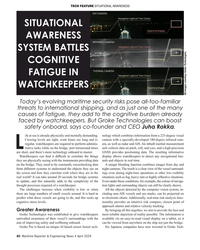 )
April 2024 - Maritime Reporter and Engineering News page: 40
)
April 2024 - Maritime Reporter and Engineering News page: 40TECH FEATURE SITUATIONAL AWARENESS SITUATIONAL AWARENESS SYSTEM BATTLES COGNITIVE FATIGUE IN WATCHKEEPERS All images courtesy Groke Technologies Today’s evolving maritime security risks pose all-too-familiar threats to international shipping, and as just one of the many causes of fatigue, they add
-
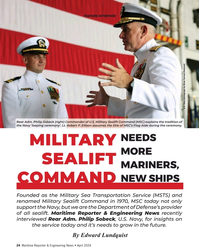 )
April 2024 - Maritime Reporter and Engineering News page: 24
)
April 2024 - Maritime Reporter and Engineering News page: 24as the Military Sea Transportation Service (MSTS) and renamed Military Sealift Command in 1970, MSC today not only support the Navy, but we are the Department of Defense’s provider of all sealift. Maritime Reporter & Engineering News recently interviewed Rear Adm. Philip Sobeck, U.S. Navy, for insights
-
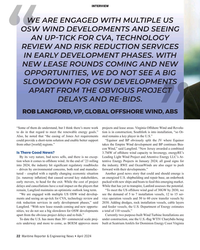 )
April 2024 - Maritime Reporter and Engineering News page: 22
)
April 2024 - Maritime Reporter and Engineering News page: 222030. Adding dredges, rock installation vessels, cable layers Langford. “With new lease rounds coming and new opportu- and feeder vessels, the U.S. Department of Energy estimates nities, we do not see a big slowdown for OSW developments a total of 110 vessels.” apart from the obvious project delays and
-
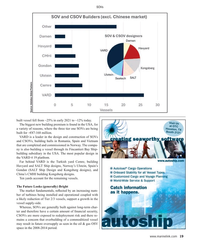 )
April 2024 - Maritime Reporter and Engineering News page: 19
)
April 2024 - Maritime Reporter and Engineering News page: 19SOVs Source: Intelatus Global Partners built vessel fell from ~25% in early 2021 to ~12% today. Visit Us The biggest new building premium is found in the USA, for at OTC Houston, TX a variety of reasons, where the three tier one SOVs are being Booth 2121 built for ~€87-168 million. VARD is a leader in
-
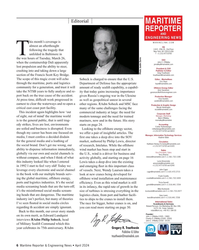 )
April 2024 - Maritime Reporter and Engineering News page: 6
)
April 2024 - Maritime Reporter and Engineering News page: 6of this tragic event will echo Sobeck is charged to ensure that the U.S. Editor - MarineNews Eric Haun through the maritime, ports and logistics Department of Defense has the appropriate [email protected] community for a generation, and trust it will amount of ready sealift capability, a capabil- Offshore
-
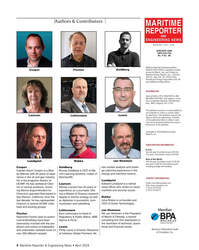 )
April 2024 - Maritime Reporter and Engineering News page: 4
)
April 2024 - Maritime Reporter and Engineering News page: 4Authors & Contributors MARITIME REPORTER AND ENGINEERING NEWS M A R I N E L I N K . C O M ISSN-0025-3448 USPS-016-750 No. 4 Vol. 86 Maritime Reporter/Engineering News (ISSN # 0025-3448) is published monthly Cooper Fischer Goldberg except for March, July, and October by Maritime Activity Reports, Inc.
-
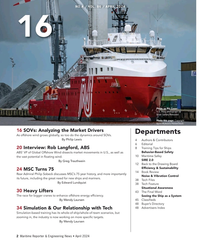 )
April 2024 - Maritime Reporter and Engineering News page: 2
)
April 2024 - Maritime Reporter and Engineering News page: 2the Cover: U.S. Navy photograph by Brian Suriani/Released Photo this page: Copyright Björn Wylezich/AdobeStock 16 SOVs: Analyzing the Market Drivers Departments As offshore wind grows globally, so too do the dynamics around SOVs. By Philip Lewis 4 Authors & Contributors 6 Editorial 8 Training Tips for Ships 20
-
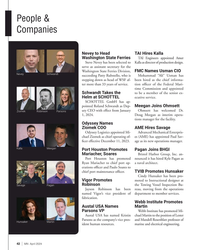 )
April 2024 - Marine News page: 42
)
April 2024 - Marine News page: 42Robinson the Towing Vessel Inspection Bu- Savage Pagan Jayson Robinson has been reau, moving from the operations named Vigor’s vice president of department to member services. fabrication. Webb Institute Promotes Austal USA Names Martin Parsons VP Webb Institute has promoted Mi- Austal USA has named
-
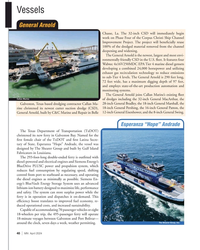 )
April 2024 - Marine News page: 40
)
April 2024 - Marine News page: 40General Arnold, built by C&C Marine and Repair in Belle 12-inch General Eisenhower, and the 8-inch General Swing. Esperanza “Hope” Andrade The Texas Department of Transportation (TxDOT) christened its new ferry in Galveston Bay. Named for the ? rst female chair of the TxDOT and ? rst Latina Secre- tary
-
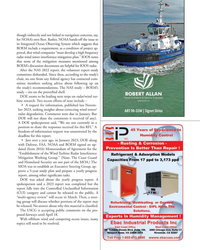 )
April 2024 - Marine News page: 25
)
April 2024 - Marine News page: 25though indirectly and not linked to navigation concerns, say, for NOAA’s own ? eet. Rather, NOAA hands-off the issue to its Integrated Ocean Observing System which suggests that BOEM include a requirement, as a condition of project ap- proval, that wind companies “must develop a high frequency radar
-
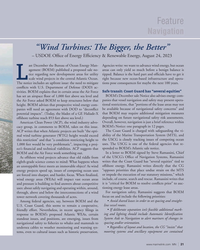 )
April 2024 - Marine News page: 21
)
April 2024 - Marine News page: 21and opera- The notice includes an upfront issue: the need to mitigate tions pose consequences for maybe the next 100 years. con? icts with U.S. Department of Defense (DOD) ac- Safe transit: Coast Guard has “several equities” tivities. BOEM explains that in certain areas the Air Force BOEM’s December
-
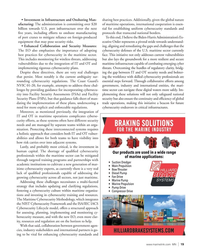 )
April 2024 - Marine News page: 19
)
April 2024 - Marine News page: 19• Investment in Infrastructure and Onshoring Man- sharing best practices. Additionally, given the global nature ufacturing: The administration is committing over $20 of maritime operations, international cooperation is essen- billion towards U.S. port infrastructure over the next tial for establishing
-
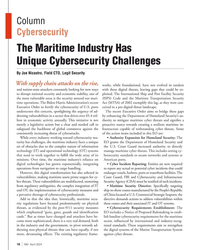 )
April 2024 - Marine News page: 18
)
April 2024 - Marine News page: 18of ad- The recent Executive Order aims to bridge these gaps dressing vulnerabilities in a sector that drives over $5.4 tril- by enhancing the Department of Homeland Security’s au- lion in economic activity annually. This initiative is not thority to mitigate maritime cyber threats and sign
-
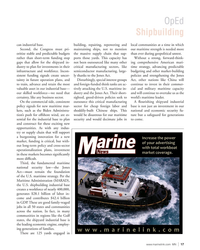 )
April 2024 - Marine News page: 17
)
April 2024 - Marine News page: 17OpEd Shipbuilding can industrial base. building, repairing, repowering and local communities at a time in which Second, the Congress must pri- maintaining ships, not to mention our maritime strength is needed more oritize stable and predictable budgets the massive supply chain that sup- than ever
-
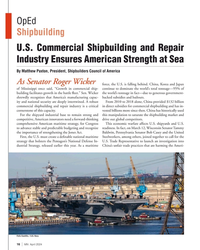 )
April 2024 - Marine News page: 16
)
April 2024 - Marine News page: 16OpEd Shipbuilding U.S. Commercial Shipbuilding and Repair Industry Ensures American Strength at Sea By Matthew Paxton, President, Shipbuilders Council of America As Senator Roger Wicker force, the U.S. is falling behind. China, Korea and Japan of Mississippi once said, “Growth in commercial ship-
-
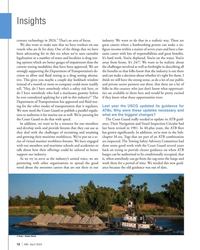 )
April 2024 - Marine News page: 12
)
April 2024 - Marine News page: 12current testing modalities that have been approved. We are the challenges involved as well as forthright in describing all strongly supporting the Department of Transportation’s de- the bene? ts so that folks know that the industry is out there cision to allow oral ? uid testing as a drug testing alterna-
-
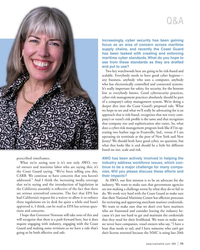 )
April 2024 - Marine News page: 11
)
April 2024 - Marine News page: 11Q&A Increasingly, cyber security has been gaining focus as an area of concern across maritime supply chains, and recently the Coast Guard has been tasked with creating and enforcing maritime cyber standards. What do you hope to see from these standards as they are drafted and put to use? Two key
-
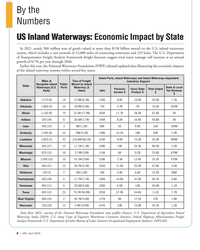 )
April 2024 - Marine News page: 8
)
April 2024 - Marine News page: 8$158 billion moved on the U.S. inland waterways system, which includes a vast network of 12,000 miles of connecting waterways and 219 locks. The U.S. Department of Transportation Freight Analysis Framework freight forecasts suggest total water tonnage will increase at an annual growth of 0.7% per year through
-
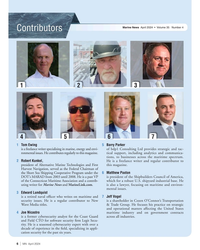 )
April 2024 - Marine News page: 6
)
April 2024 - Marine News page: 6Marine News April 2024 • Volume 35 Number 4 Contributors 1 2 3 5 4 6 7 1 Tom Ewing 5 Barry Parker is a freelance writer specializing in marine, energy and envi- of bdp1 Consulting Ltd provides strategic and tac- ronmental issues. He contributes regularly to this magazine. tical support, including
-
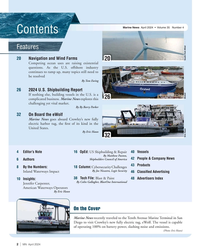 )
April 2024 - Marine News page: 2
)
April 2024 - Marine News page: 2Marine News April 2024 • Volume 35 Number 4 Contents Features 20 Navigation and Wind Farms 20 Competing ocean uses are raising existential questions. As the U.S. offshore industry continues to ramp up, many topics still need to be resolved By Tom Ewing 26 2024 U.S. Shipbuilding Report If
-
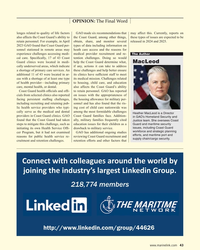 )
February 2024 - Maritime Reporter and Engineering News page: 43
)
February 2024 - Maritime Reporter and Engineering News page: 43OPINION: The Final Word lenges related to quality of life factors GAO made six recommendations that may affect this. Currently, reports on also affects the Coast Guard’s ability to the Coast Guard, among other things, these types of issues are expected to be retain personnel. For example, in April
-
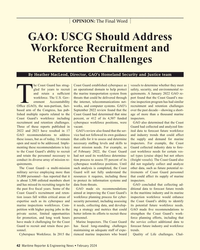 )
February 2024 - Maritime Reporter and Engineering News page: 42
)
February 2024 - Maritime Reporter and Engineering News page: 42OPINION: The Final Word GAO: USCG Should Address Workforce Recruitment and Retention Challenges By Heather MacLeod, Director, GAO’s Homeland Security and Justice team he Coast Guard has strug- Coast Guard established cyberspace as vessels to determine whether they meet gled for years to recruit an
